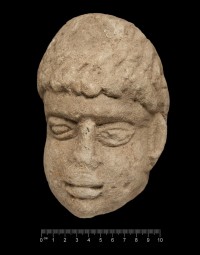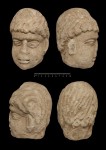1,800-year-old stone head of an eminent African-Featured Romano-British found in Binchester, Durham England by Oguejiofo Annu

Archaeologists from Durham University England, who were excavating an ancient site of a Roman bathhouse outside Binchester Roman Fort near the town of Bishop Auckland, County Durham, northeast England, found a carved stone head of a black man dating to the 2nd or 3rd century A.D.
The small sandstone sculpture is about eight inches high and four inches wide — in a layer of stone rubble. Two years ago a small Roman altar was found nearby.

Archaeologists believe the head period the Romans ruled England. Binchester was a fort on the northern frontier.
The Binchester head also has facial features — mainly the modeling of the nose and lips — that may suggest an African influence.
I would emphatically call him a Moor because in the time of the Romans, so-called black people of today were called Moors and Melaneos. Those Moors were native to Britain, they were the first British, before the invasion of the Island by the Albions, and the Goths, the Vinlanders etc.
The Binchester head is African in appearance, and the experts cannot deny their own eyes no matter how hard they try. But Dr Petts, who is also Associate Director of Durham University’s Institute of Medieval and Early Modern Studies, said experts were unsure whether these features were “deliberate or coincidental”.
He explained: “This is something we need to consider deeply. If it is an image of an African, it could be extremely important, although this identification is not certain.”
The most interesting aspect is this so-called African features were carved into all images and statues found in England dating from that same period. Due to to its pervasity in the art of that period, the scholars have attempted to rebrand its identity and localise it.
According to Dr Mason one of the scholars involved in the study: “The African style comparison may be misleading as the form is typical of that produced by local craftsmen in the frontier region.”
Binchester Roman Fort, called Vinovia by the Romans, was the largest fort in the county, housing a garrison of one thousand men, most if not all of them cavalry. It guarded the crossing point of the River Wear, a strategically important location about 60 miles north of the legion’s headquarters at York and about 30 miles south of Hadrian’s Wall.
Binchester Fort is in the centre of today’s County Durham, approximately one and a half miles north of Bishop Auckland in England.

Sources
@ Durham county council: Visit Binchester Roman Fort




I agree — the nose (what is left of it) and lips indicate the image of a person with a significant Black African component to his heritage. I would also add that the structure of the jaw contributes to this judgment — the jaw does not recede, but is somewhat prognathous. Oh, and what a surprise — the nose is missing.
A lot of the English news websites are ignoring this aspect of the discovery, even though Dr. Petts does address it somewhat (though he dismisses it as inconclusive).
Does anybody want to make a comment about the carving of the hair?
Look up “Dravidian”, as there are Native Africans who have straight hair; it’s a stereotype that all Africans only have tight curls for their hair, and that’s simply not true.
http://news.bbc.co.uk/nol/shared/spl/hi/picture_gallery/04/africa_african_maid/img/1.jpg
Or simply, look on the site you are on:
http://www.africaresource.com/rasta/sesostris-the-great-the-egyptian-hercules/the-straight-haired-africans-oguejiofo-annu/
So the White Man really wrote himself into History… The more I read on European History the darker it gets
Africans used to live in all the four corners of the earth..in india the white indians come from the blcak andamanese and in japan The Anui people